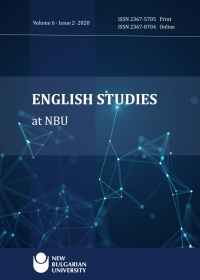Evaluating the Performance of a New Text Rhythm Analysis Tool
DOI:
https://doi.org/10.33919/esnbu.20.2.3Keywords:
text rhythm analysis, diacope, epanalepsis, anaphora, epiphora, symploce, epizeuxis, anadiplosisAbstract
The paper assesses and evaluates the performance of the ProseRhythmDetector (PRD) Text Rhythm Analysis Tool. The research is a case study of 50 English and 50 Russian fictional texts (approximately 88,000 words each) from the 19th to the 21st century. The paper assesses the PRD tool accuracy in detecting stylistic devices containing repetition in their structure such as diacope, epanalepsis, anaphora, epiphora, symploce, epizeuxis, anadiplosis, and polysyndeton. The article ends by discussing common errors, analysing disputable cases and highlighting the use of the tool for author and idiolect identification.
Downloads
Published
How to Cite
Issue
Section
License
All published articles in the ESNBU are licensed under the Creative Commons Attribution-NonCommercial 4.0 International License (CC BY-NC 4.0). This license lets others remix, tweak, and build upon your work non-commercially, and although their new works must also acknowledge you and be non-commercial, they don't have to license their derivative works on the same terms.
In other words, under the CC BY-NC 4.0 license users are free to:
Share - copy and redistribute the material in any medium or format
Adapt - remix, transform, and build upon the material
Under the following terms:
 Attribution (by) - All CC licenses require that others who use your work in any way must give you credit the way you request, but not in a way that suggests you endorse them or their use. If they want to use your work without giving you credit or for endorsement purposes, they must get your permission first.
Attribution (by) - All CC licenses require that others who use your work in any way must give you credit the way you request, but not in a way that suggests you endorse them or their use. If they want to use your work without giving you credit or for endorsement purposes, they must get your permission first. NonCommercial (nc) - You let others copy, distribute, display, perform, and modify and use your work for any purpose other than commercially unless they get your permission first.
NonCommercial (nc) - You let others copy, distribute, display, perform, and modify and use your work for any purpose other than commercially unless they get your permission first.
If the article is to be used for commercial purposes, we suggest authors be contacted by email.
If the law requires that the article be published in the public domain, authors will notify ESNBU at the time of submission, and in such cases the article shall be released under the Creative Commons 1 Public Domain Dedication waiver CC0 1.0 Universal.
Copyright
Copyright for articles published in ESNBU are retained by the authors, with first publication rights granted to the journal. Authors retain full publishing rights and are encouraged to upload their work to institutional repositories, social academic networking sites, etc. ESNBU is not responsible for subsequent uses of the work. It is the author's responsibility to bring an infringement action if so desired by the author.
Exceptions to copyright policy
Occasionally ESNBU may co-publish articles jointly with other publishers, and different licensing conditions may then apply.






